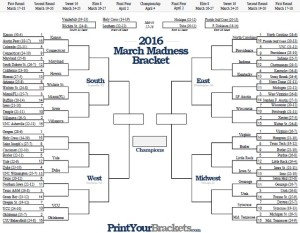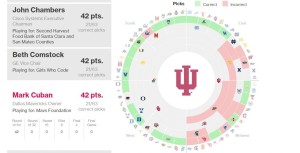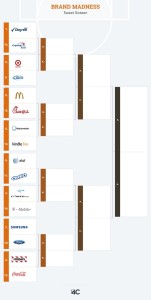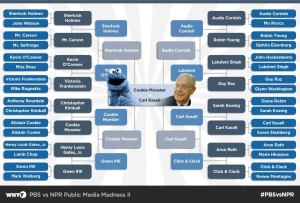It’s that time of year again, and it’s unlikely that you’ve made it to March 18 without being roped into (or gleefully entered into) some sort of NCAA tournament pool either with your office mates, your classmates, your family, or random strangers on the Internet. “March Madness,” as the three week, 68 team college basketball tournament has come to be known, kicked off yesterday with teams vying for spots in regional tournaments which will eventually result in a final round between the top two teams. From its humble beginnings in 1939, the tournament has reached astronomical heights of viewership with an estimated 28.3 million people watching the final game in 2015 (Steinberg, 2016).
A recent blog post in the Huffington Post moved beyond the sheer popularity of the tournament itself and into the topic of the wild success of the event’s marketing, holding up the NCAA’s marketing team as one from which we can all learn. Of the many tactics mentioned in the “What marketers can learn from March Madness Marketing” section of this post, some key examples include: their use of names and logos that are easy to remember (including many alliterative terms: March Madness, Sweet Sixteen, Final Four . . . ), tie-ins with events, successful promotions, and social media brilliance (Kalb, 2016).
 While all of this is beyond-a-doubt true, I’d argue that there is something simply appealing and “sticky” about the centerpiece of all the “madness”: the bracket. Something about these symetrical narrowing sets of lines that all converge at the center is captivating to Americans. It is estimated that 60 million people filled out brackets last year, and the American Gaming Association estimates that $9.2 billion will change hands through bracket betting in 2016 (Steinberg, 2016).
While all of this is beyond-a-doubt true, I’d argue that there is something simply appealing and “sticky” about the centerpiece of all the “madness”: the bracket. Something about these symetrical narrowing sets of lines that all converge at the center is captivating to Americans. It is estimated that 60 million people filled out brackets last year, and the American Gaming Association estimates that $9.2 billion will change hands through bracket betting in 2016 (Steinberg, 2016).
And, based on the idea that imitation is the greatest form of flattery, I’d like to demonstrate just how beloved the bracket itself is by highlighting three bracket spin-off trends that illustrate how the bracket concept spreads through our pop culture every March and, even when it strays from the initial spirit of the NCAA tournament, still links back to the basketball non-profit and provides it with even more marketing attention.
1 . People harnessing the NCAA bracket for purposes outside of personal entertainment and betting. Outside of the traditional office or family pool, March Madness brackets are now being put to other uses as well. A great instance of this can be found in this example from Bloomberg.com in which not only is the original shape of the bracket transformed into a visually cool, moving circle graphic, but the stakes are also high and, most significantly, all for good causes. In this “pool,” as Bloomberg states, “We brought together a group of titans from the worlds of business and finance to take their best shot at filling out the perfect March Madness bracket. Each of the participants is donating $10,000, with the total pot going to the victor’s charity of choice” (“Bloomberg Brackets for a Cause,” 2016). To check out “Brackets for a Cause,” click here.
. People harnessing the NCAA bracket for purposes outside of personal entertainment and betting. Outside of the traditional office or family pool, March Madness brackets are now being put to other uses as well. A great instance of this can be found in this example from Bloomberg.com in which not only is the original shape of the bracket transformed into a visually cool, moving circle graphic, but the stakes are also high and, most significantly, all for good causes. In this “pool,” as Bloomberg states, “We brought together a group of titans from the worlds of business and finance to take their best shot at filling out the perfect March Madness bracket. Each of the participants is donating $10,000, with the total pot going to the victor’s charity of choice” (“Bloomberg Brackets for a Cause,” 2016). To check out “Brackets for a Cause,” click here.
2. Brac kets for things that surround the games themselves, yet are not basketball teams. A few years ago, people started realizing that it wasn’t just the teams on the court that were vying for victories, but also the commercials and the brands advertised during the games’ breaks. This competition, then, was visualized in the bracket format, as shown here by Adweek’s “Brand Bracket,” which gauged each company’s engagement prowess with metrics such as clicks and comments. For the whole story, and to learn who last year’s winner was, click here.
kets for things that surround the games themselves, yet are not basketball teams. A few years ago, people started realizing that it wasn’t just the teams on the court that were vying for victories, but also the commercials and the brands advertised during the games’ breaks. This competition, then, was visualized in the bracket format, as shown here by Adweek’s “Brand Bracket,” which gauged each company’s engagement prowess with metrics such as clicks and comments. For the whole story, and to learn who last year’s winner was, click here.
3. Companies, organizations, and individuals who create spin-offs of the bracket concept that have zero to do with basketball or anything relating to the tournament. These are the most inventive copycat iterations of the March Madness brackets, for they take advantage of the basic simplicity of the bracket and use it to stage imaginary or user-driven contests between concocted rivalries. Star Wars character brackets, one decade against another brackets, breakfast cereal brackets, J.R.R. Tolkien brackets, book brackets, cocktail brackets . . . you name it. If there is the potential for comparison, a br acket can be made. (See more here).
acket can be made. (See more here).
I have to confess, I have a penchant for the nerdy strain of these, and I love a good NPR show bracket. They, however, come in second to my absolute favorite: the NPR vs. PBS host bracket. To get a closer look at it, click here.
The brilliance of all of this bracketology imitation is that, regardless of the fact that these creations often have no link whatsoever to the NCAA tournament, they do, by virtue of using the “March Madness” label or close approximations, inevitably loop back to the NCAA in people’s minds and thereby provide it with free marketing. And that is a strategy, intended or not, that is far less “broken” than my own NCAA bracket, which, unfortunately, was hinging on the success of Michigan State.
Reference:
Bloomberg Brackets for a Cause. (2016, March 15). Bloomberg. Retrieved from http://www.bloomberg.com/graphics/2016-brackets-for-a-cause/
Kalb, I. (2016, March 11). March Madness Marketing: Another Slam Dunk for the NCAA in 2016. Huffington Post. Retrieved from http://www.huffingtonpost.com/ira-kalb/march-madness-marketing-a_b_9443412.html
Steinberg, L. (2016, March 16). March Madness off the Charts. Forbes. Retrieved from http://www.forbes.com/sites/leighsteinberg/2016/03/16/march-madness-popularity-off-the-charts/#37d0e6267cea

One Response to Bracket Madness: March’s Imitation Game Spells Victory for the NCAA